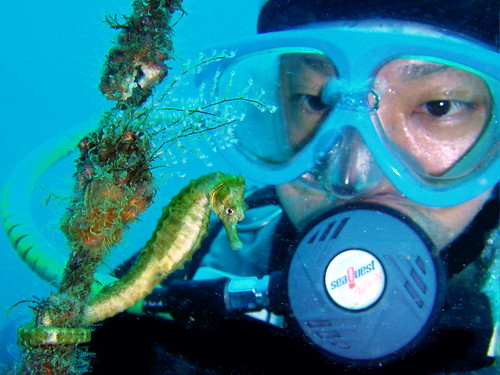Did you have seen a Seahorse swimming away from you when you're diving near them? It so cute animal that I really likes. Seahorses are any species belonging to the genus Hippocampus, which, in turn, belongs to the family Syngnathidae, which also includes pipefish and leafy sea dragons. There are over 47 species of seahorse, mainly found in shallow tropical and temperate waters throughout the world. They prefer to live in sheltered areas such as sea grass beds, coral reefs, or mangroves.
Photo: Nemo
Three different species of seahorse live in the Mediterranean Sea:
- Hippocampus hippocampus (long snout)
- Hippocampus brevirostris (short snout)
- Hippocampus fuscus (immigrated from the Red Sea)
Pipefish look like straight-bodied seahorses with tiny mouths. The name is derived from the peculiar form of their snout, which is like a long tube, ending in narrow and small mouth which opens upwards and is toothless. The body and tail are long, thin, and snake-like. They have a highly modified skeleton formed into armored plating. This dermal skeleton has several longitudinal ridges, so that a vertical section through the body looks angular, not round or oval as in the majority of other fishes.
Many Pipefish are very weak swimmers in open water, moving slowly by means of rapid movements of the dorsal fin. Some species of pipefish have tails that are prehensile as in seahorses. The majority of pipefishes have some form of a caudal fin which unlike seahorses, that can be used for locomotion.
Photo: getahugetank.com
These fish form territories, with males staying in about one square meter of their habitat while females range about one hundred times that area. They bob around in sea grass meadows, mangrove stands, and coral reefs where they are camouflaged by murky brown and grey patterns that blend into the sea grass backgrounds. During social moments or in unusual surroundings, seahorses turn bright colors.
Seahorses are rather inept swimmers and can easily die of exhaustion when caught in storm-roiled seas. They propel themselves by using a small fin on their back that flutters up to 35 times per second. Even smaller pectoral fins located near the back of the head are used for steering.
They anchor themselves with their prehensile tails to sea grasses and corals, using their elongated snouts to suck in plankton and small crustaceans that drift by. Voracious eaters, they graze continually and can consume 3,000 or more brine shrimp per day.
Photo: animals.nationalgeographic.com
Seahorses are so named for their equine profile. Although they are bony fish, they do not have scales, rather a thin skin stretched over a series of bony plates arranged in rings throughout their body. Each species has a distinct number of rings.
Seahorses swim upright, another characteristic that is not shared by their close pipefish relatives, which swim horizontally. Seahorses have a coronet on their head, which is distinct to each seahorse, much like a human fingerprint. They swim very poorly by using a dorsal fin, which they rapidly flutter to propel them, and pectoral fins, located behind their eyes, which they use to steer.
Seahorses have no caudal fin. As they are poor swimmers, they are most likely to be found resting in beds of sea grass or coral reefs, with their prehensile tails wound around a stationary object. They have long snouts, which they use to suck up food, and eyes that can move independently of each other, much like a chameleon. Seahorses eat small shrimp, tiny fish and plankton.
Photo: Felicia McCaulley
Seahorses typically mate for life. The male seahorse is equipped with a brood pouch on the ventral, or front-facing, side. When mating, the female seahorse deposits the eggs in the male's pouch, which the male then internally fertilizes. The male carries the eggs until they emerge, expelling fully-developed, miniature seahorses in the water.
Source: wikipedia.org, animals.nationalgeographic.com.
Wednesday, July 1, 2009
The Family of Seahorses and Pipefish
Labels: brevirostris, Hippocampus, Pipefish, Seahorses, Syngnathidae
Posted by ThanateTan at 3:26 AM
Subscribe to:
Post Comments (Atom)


1 comments:
Interesting site you got here. I do like to this too. More power
Post a Comment